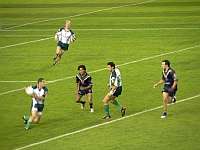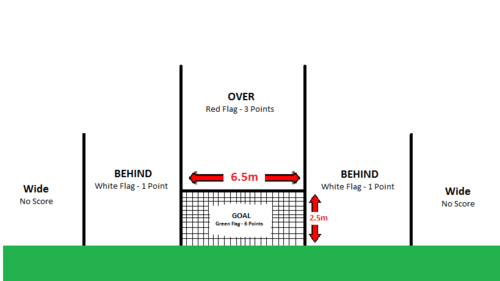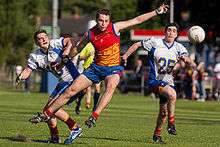International rules football
 An international rules football match at the Etihad Stadium in Melbourne, Victoria, Australia, between Australia and Ireland | |
| Highest governing body | |
|---|---|
| Nicknames | IR, International rules, Compromise rules |
| First played | 1967 (Australian Football World Tour) |
| Characteristics | |
| Contact | Yes |
| Team members | 15 |
| Mixed gender | Single (male only at elite level) |
| Type | Outdoor |
| Equipment | Gaelic football |
| Presence | |
| Olympic | No |
| Paralympic | No |
International rules football (Irish: Peil na rialacha idirnáisiunta; also known as international rules in Australia and compromise rules in Ireland) is a team sport consisting of a hybrid of football codes, which was developed to facilitate international representative matches between Australian rules football players and Gaelic football players.
The first tour, known as the Australian Football World Tour, took place in 1967, with matches played in Ireland, the United Kingdom, and the United States. The following year, games were played between Australia and a touring County Meath Gaelic football team, Meath being the reigning All-Ireland senior football champions.[1] Following intermittent international tests between Australia and Ireland, the International Rules Series between the senior Australian international rules football team and Ireland international rules football team has been played intermittently since 1984, and has generally been a closely matched contest. The sport has raised interest and exposure in developing markets for Gaelic and Australian football and has been considered a development tool by governing bodies of both codes, particularly by the AFL Commission.
International rules football does not have any dedicated clubs or leagues. It is currently played by men's, women's, and junior teams only in tournaments or Test matches.
Rules
The rules are designed to provide a compromise or combine between those of the two codes, with Gaelic football players being advantaged by the use of a round ball and a rectangular field measured about 160 yards long by 98 yards wide (Australian rules uses an oval ball and field), while the Australian rules football players benefit from the opportunity to tackle by grabbing between the shoulders and thighs and pulling to the ground, something banned in Gaelic football. The game also introduces the concept of the mark, from Australian rules football, with a free kick awarded for a ball caught from a kick of over 15 metres, where the kick must be in the forward direction if originating from a teammate.[2]
A player must bounce, solo (kick into one's own hands) or touch the ball on the ground once every 10 metres or six steps.[2] A maximum of two bounces per possession are allowed, while players can solo the ball as often as they wish on a possession.[2] Unlike in Gaelic football, the ball may be lifted directly off the ground, without putting a foot underneath it first.[2] Players however cannot scoop the ball off the ground to a team-mate, nor pick up the ball if they are on their knees or on the ground.[2] If a foul is committed, a free kick will be awarded, though referees (called umpires in Australian Rules) can give the fouled player advantage to play on at their discretion.[2]

The game uses two large posts usually sets 6.5 metres apart, and connected 2.5 metres above the ground by a crossbar with a goal net that could extend behind the goalposts and attached to the crossbar and lower goalposts, as in Gaelic football. A further 6.5 metres apart on either side of those and not connected by a crossbar are 2 small posts, known as behind posts, as in Australian rules football.
Points are scored as follows
- Under the crossbar and into the goal net (a goal): 6 points, umpire waves a green flag and raises both index fingers.[2]
- Over the crossbar and between the two large posts (an over): 3 points, umpire waves red flag and raises one arm above his head.[2]
- Between either of the large posts and small posts (a behind): 1 point, umpire waves white flag and raises one index finger.[2]
Scores are written so as to clarify how many of each type of score were made as well as, like Australian football, giving the total points score for each team; for example, if a team scores one goal, four overs and 10 behinds, the score is written as 1-4-10 (28), meaning one goal (six points) plus 4 overs (4 × 3 = 12 points) plus 10 behinds (10 × 1 = 10 points), for a total score of 28 points.
An international rules match lasts for 72 minutes (divided into four quarters of 18 minutes each).[2] Inter-county Gaelic football matches go on for 70 minutes, divided into two halves, and Australian rules matches consist of four 20 minute quarters of game time, although with the addition of stoppage time, most quarters actually last between 25 and 30 minutes.
As in Gaelic football, teams consist of fifteen players, including a goalkeeper, whereas eighteen are used in Australian rules (with no keeper).
2006 rule changes
A number of rule changes were introduced before the 2006 International Rules Series:
- Time per quarter was reduced from 20 minutes to 18 minutes.
- A player who received a red card is to be sent off and no replacement is allowed; in addition to this a penalty is awarded regardless of where the incident takes place. (Previously a replacement was allowed and a penalty was only awarded if the incident happened in the penalty area.)[3]
- A yellow card now means a 15-minute sin bin for the offending player, who will be sent off if he receives a second card.[4]
2008 rule changes
- Maximum of 10[5] interchanges per quarter.
- Teams are allowed only four consecutive hand passes (ball must then be kicked).[5]
- Match time reduced from 80 minutes to 72 minutes (18 minutes per quarter).[2]
- The goalkeeper can no longer kick the ball to himself from the kick-out.[2]
- Suspensions may carry over to GAA and AFL matches if the Match Review Panel sees fit.[2]
- A dangerous "slinging" tackle will be an automatic red card.
- A front-on bump (known as a shirtfront in Australian football) endangering the head will result in a red card.
- Physical intimidation can result in a yellow card.
- The keeper cannot be tackled or touched when the keeper is charging.
- An independent referee can cite players for reportable offences from the stands.
- Yellow card sin bin reduced to 10 minutes.[2]
2014 rule changes
- Maximum number of interchanges per quarter increased from 10 to 16.
- Unlimited number of interchanges allowed at quarter and half time breaks.
- Number of consecutive hand-passes teams are allowed increased from 4 to 6.
- Marks will not be paid for backwards kicks caught by a teammate.
- Goalkeepers required to kick the ball out beyond the 45 m line after all wides, behinds and overs.
- Failure of a goalkeeper to kick over the 45 m line will result in a free kick to the opposition (from the 45 m line).[6]
Women's international rules football
While ladies' Gaelic football has been growing almost exponentially since the 1970s, Women's Australian rules football has far fewer players, though numbers have grown strongly since the 1990s. In early 2006, representatives of the Ladies' Gaelic Football Association and Women's Australian Football Leagues met at a Ladies' Gaelic football festival in Singapore, and agreed to compete in the hybrid version of the two football codes to coincide with the senior men's series. The 2006 Women's Series has been the only series to take place.
| Date | Teams | Stadium | Location | Attendance | |
|---|---|---|---|---|---|
| 31 October 2006 | Ireland 6.26.16 (134) def. Australia 1.2.3 (15) | Breffni Park | Cavan | [7][8] | |
| 4 November 2006 | Ireland 3.5.6 (39) def. Australia 0.4.6 (18) | Parnell Park | Dublin | [8] |
Juniors
Among the first schoolboys' international tests was that played in Melbourne in 1983, when a Victorian under-17 team played Ireland. An interesting twist in these compromise matches is that the ball used was the oval shaped Australian football rather than the round ball.[9]
An official junior series at Under-17 level has been played in alternate nations since the early 2000s. Ireland completed a hat-trick of series wins from 2003–2005 before Australia won the junior series for 2006. The junior series was largely instituted by both leagues as a means to identify emerging talent. It has since been abandoned.
| Date | Result | Venue Location | Age | Notes |
|---|---|---|---|---|
| 2005 Game 1 | Ireland 73 def. Australia 32 | Crossmaglen, County Armagh | U/17 | [10] |
| 2005 Game 2 | Ireland 44 def. by Australia 56 | Dublin, County Dublin | U/17 | [10] |
| 2005 Game 3 | Ireland 39 def. Australia 31 | Killarney, County Kerry | U/17 | [10] |
- Australian player of the series: Joel Selwood
- Irish player of the series: Ray Cullivan
| Date | Result | Venue Location | Age | Notes |
|---|---|---|---|---|
| 2006 Game 1 | Australia 0.11.6 (39) drew Ireland 2.7.6 (39) | Docklands Stadium, Melbourne | U/17 | [11] |
| 2006 Game 2 | Australia 1.6.11 (35) drew Ireland 3.4.5 (35) | Football Park, Adelaide | U/17 | [11] |
| 2006 Game 3 | Australia 2.6.15 (45) def. Ireland 1.6.6 (30) | Fremantle Oval, Perth | U/17 | [12] |
- Irish player of the series: Kevin Nolan
- Australian player of the series: Bryce Gibbs
Amateurs
The Australian Amateur Football Council has sent an amateur Under-23 All-Australian team to Ireland in both 2005 and 2008. The Australian amateur team wore a different jersey to the AFL representative side, dark green and gold, with a kangaroo emblem. Recently, the Victorian Amateur Football Association (VAFA) has sent a squad of players sourced from the top six divisions of its competition to tour Ireland and play various clubs and representative teams.[13]
| Date | Teams | Stadium | Location | Attendance | Notes |
|---|---|---|---|---|---|
| 2005 | AAFC (U-23) 17 def. by Ireland GAA 105 | Croke Park | Dublin, County Dublin | N/A | [14] |
| 2005 | AAFC (U-23) 30 def. by All-Ireland Universities 34 | University Grounds | National University of Ireland, Galway | N/A | [14] |
| 2005 | AAFC (U-23) 74 def. Irish Banks/Allied Forces 52 | Pearse Stadium | Galway, County Galway | N/A | [14] |
| 2005 | AAFC (U-23) 53 def. Bishopstown GAA 47 | Bishopstown GAA Club | Cork County Cork | N/A | [14] |
| 2008 | AAFC (U-23) 46 def. Bishopstown GAA 39 | Bishopstown GAA Club | Cork, County Cork | [15] | |
| 2008 | AAFC (U-23) 55 def. by Donaghmore Ashbourne 60 | Killegland West | Ashbourne, County Meath | 2,500 | [15] |
| 2008 | Sydney AFL 43 def. NSW GAA 42 | Mahoney Park | Marrickville, New South Wales | [16] | |
| 2011 | VAFA 28 def. Donaghmore Ashbourne 26 | Killegland West | Ashbourne, County Meath | [13] | |
| 2011 | VAFA 7 def. by Ireland GAA 81 | Croke Park | Dublin, County Dublin | [13] | |
| 2013 | VAFA 102 def. Na Piarsaigh 16 | Páirc Uí Chonaire | Cork City, County Cork | [17] | |
| 2013 | VAFA 0.10.9 (39) def. by Combined Dublin Universities 4.10.3 (57) | St Vincent's GAA Club | Marino, Dublin, County Dublin | [18] |
Masters
International rules also has a masters category with several competitions. There is also a Masters International Rules Series which follows the format of the senior men's series and involves many retired Australian Rules and Gaelic Football players.
International rules football around the world

International rules is played in various locations throughout North America and the Caribbean, Europe, Asia, and Australia and New Zealand between fledgling Australian rules football and Gaelic football clubs.
In 2006, an exhibition match between South African youth teams and an Indigenous Australian touring side composed of players from the Clontarf Foundation, led by Sydney's Adam Goodes, was held at Potchefstroom.
The University of Birmingham, UK, holds an annual International Rules match between its Australian Rules football team and its Gaelic Football team, with the 2013 edition won by the Australian Rules team 56–55, before a crowd of over 400 students.[19]
In the International Rules Series, the most well-known International Rules event, Australia and Ireland are at an impasse, with 10 series wins apiece. Most recently in 2017, Australia defeated Ireland with two Test wins and an aggregate score of 116-103.
See also
References
- ↑ "History of International Rules Football". Retrieved 18 April 2008.
- 1 2 3 4 5 6 7 8 9 10 11 12 13 14 Heaney, Paddy (23 October 2008). "The rules of engagement: A brief guide". The Irish News. p. 58.
- ↑ "Rule changes for International series agreed". Rte.ie. 2007-06-14. Retrieved 2017-03-15.
- ↑
- 1 2 Heaney, Paddy (23 October 2008). "Time for talk is over". The Irish News. p. 58.
- ↑ "No more short kick-outs for International Rules". Rte.ie. 2014-07-22. Retrieved 2017-03-05.
- ↑ "Breffni Park hosts first-ever women's International Rules tie". Irish Examiner. 2006-10-31. Retrieved 2009-10-26.
- 1 2 "Brave Aussie ladies like ewes to the slaughter in Ireland". World Footy News. 2006-11-14. Retrieved 2013-05-22.
- ↑ "Image A6180, 29/7/83/11". National Archives of Australia. Retrieved 6 January 2008.
- 1 2 3 Peter Parry. "Ireland take U-17 IR series 2-1". World Footy News. Retrieved 2017-03-05.
- 1 2 Peter Parry. "Two drawn Tests and Under 17's series rests on Fremantle Test". World Footy News. Retrieved 2017-03-05.
- ↑ Peter Parry. "Australia win decider in youth IR series". World Footy News. Retrieved 2017-03-05.
- 1 2 3 "Big V in Ireland". Archived from the original on 6 October 2013.
- 1 2 3 4 Peter Parry. "Under 23 Australian Amateurs tour of Ireland". World Footy News. Retrieved 2017-03-05.
- 1 2 Peter Parry. "Australian Amateurs Under 23 tour of Ireland". World Footy News. Retrieved 2017-03-05.
- ↑ "Latest News - AFL NSW ACT - SportsTG". Sportingpulse.com. Retrieved 2017-03-05.
- ↑ "Big V Smashes Cork". Archived from the original on 6 March 2014.
- ↑ "VAFA Fall to Combined Dublin Universities". Archived from the original on 6 March 2014.
- ↑ "Aussie Rules claim victory against Gaelic Football". University of Birmingham. 6 June 2013. Archived from the original on 4 October 2013. Retrieved 14 June 2013.
External links
- International rules pages at the Gaelic Athletic Association website
- International rules pages at the Australian Football League website
- WFN international rules A catalogue of some of the scores of games in the code around the world.
- Laws of the game (Updated in 2014)
- AFL Europe Page
- Tarik's International Rules football results and rankings
